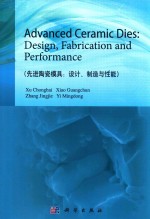

先进陶瓷模具:设计、制造与性能PDF电子书下载
- 电子书积分:9 积分如何计算积分?
- 作 者:许崇海等著
- 出 版 社:北京:科学出版社
- 出版年份:2016
- ISBN:7030472977
- 页数:192 页
Chapter 1 State of the Art of Ceramic Dies 1
1.1 Introduction 1
1.2 Composition,processing technology and mechanical property of ceramic die materials 2
1.2.1 Al2O3 based ceramics 2
1.2.2 ZrO2 based ceramics 3
1.2.3 Sialon ceramics 6
1.2.4 Si3N4 ceramics 7
1.2.5 Cermets 7
1.3 Engineering performance of ceramic dies 8
1.3.1 Drawing die 8
1.3.2 Extrusion die 10
1.3.3 Punching die 12
1.4 Surface modification techniques and their application in ceramic dies 13
1.4.1 Surface coating 13
1.4.2 Surface composite 15
1.4.3 Surface plating 16
1.5 Nanocomposite ceramics and the application in dies 17
1.5.1 Composition and mechanical property of nanocomposite ceramics 17
1.5.2 Application of nanocomposite ceramics in dies 20
References 20
Chapter 2 Optimum Design of Ceramic Die Materials with Computational Intelligence 23
2.1 Introduction 23
2.2 Optimization based on the BP algorithm 25
2.2.1 BP algorithm 26
2.2.2 Experimental data 27
2.2.3 Compositions optimization for ceramic die material 28
2.2.4 Optimization of hot pressing parameters 31
2.3 Optimization based on immune algorithm 34
2.3.1 Immune algorithm 34
2.3.2 Experimental data 37
2.3.3 Compositions optimization for cermet die material 37
2.4 Optimization with the hybrid GA-BP method 40
2.4.1 GA-BP Ⅰ algorithm 40
2.4.2 GA-BP Ⅱ algorithm 40
2.4.3 Compositions optimization for ceramic die material 43
2.4.4 Optimization of hot pressing parameters 49
2.5 Optimization with the hybrid IGA method 55
2.5.1 Process of IGA 55
2.5.2 Compositions optimization based on IGA 56
2.5.3 Optimization result 58
2.6 Optimization with the combined algorithm of BP,GA and IA 59
2.6.1 Experimental data 59
2.6.2 Optimization of the hot pressing process 60
2.6.3 Optimization of the flexural strength and hardness 63
References 65
Chapter 3 Optimum Design of the Structure of Combined Ceramic-steel Die 69
3.1 Introduction 69
3.2 Structural optimization design of the cold extrusion combined ceramic-steel die 70
3.2.1 Selection of component 71
3.2.2 Determination of parameters 71
3.2.3 Modeling 74
3.2.4 Orthogonal test 74
3.3 Thermal stress analysis of cold extrusion die 80
3.3.1 Process of finite element analysis 81
3.3.2 Distribution of temperature field 82
3.3.3 Distribution of stress field 83
3.3.4 Structural optimization 86
3.4 Thermal stress analysis of the combined die at the hot extruding 90
3.4.1 Distribution of temperature field 91
3.4.2 Distribution of stress field 92
3.5 Thermal stress analysis of the hot extrusion process 95
3.5.1 Model of the backward extrusion combined die 95
3.5.2 Distribution of temperature field 95
3.5.3 Distribution of stress field 96
3.5.4 Structural optimization 97
References 98
Chapter 4 Al2O3 Based Nano-miero Composite Ceramic Die Material 100
4.1 Material preparation 100
4.2 Test method 101
4.3 Mechanical property 102
4.3.1 Effects of the content of nano Ti(C,N)on the mechanical properties 102
4.3.2 Effects of the content of (Mo+Ni)on the mechanical properties 103
4.3.3 Effects of the hot pressing process on the mechanical properties 104
4.4 Microstructure 106
4.4.1 Effects of the content of nano Ti(C,N) on the microstructure 106
4.4.2 Effects of the content of(Mo+Ni)on the microstructure 109
4.4.3 Effects of the hot pressing process on the microstructure 110
4.5 Toughening and strengthening mechanisms 113
4.5.1 Grain fining effect 113
4.5.2 Intragranular structure effect 113
4.5.3 Changing of fracture mode 114
4.5.4 Crack deflection 115
4.5.5 Crack bridging 115
4.5.6 Crack branching 115
4.5.7 Grain pulling-out 116
References 117
Chapter 5 ZrO2 Based Nano-micro Composite Ceramic Die Materials 119
5.1 Introduction 119
5.2 ZrO2/Ti(C,N)nano-nano composite ceramic die material 121
5.2.1 Experiment 122
5.2.2 Effect of Y2O3 content on the mechanical properties 122
5.2.3 Effect of Y2O3 content on the microstructure 124
5.2.4 Toughening and strengthening mechanism 126
5.3 ZrO2/TiC micro-nano composite ceramic die materials 132
5.3.1 Experiment 132
5.3.2 Effect of TiC content on the composite material 134
5.3.3 Effect of Al2O3 content on the composite material 136
5.3.4 Effect of Y2O3 content on the composite material 137
5.3.5 Effects of CeO2 content on the composite material 139
5.3.6 Effects of hot pressing temperature on the composite material 141
5.3.7 Effects of holding time on the composite material 143
5.4 ZrO2/TiB2 nano-micro composite ceramic die material 145
5.4.1 Experiment 145
5.4.2 Components and mechanical property of ceramic material 148
5.4.3 Hot pressing parameters 150
References 156
Chapter 6 Ti(C,N)Based Nano-micro Composite Cermet Die Material 159
6.1 Material preparation 159
6.2 Test method 160
6.3 Mechanical property 160
6.3.1 Effects of the content of nano ZrO2 on the mechanical properties 160
6.3.2 Effects of the content of WC on the mechanical properties 162
6.3.3 Effects of the hot pressing process on the mechanical properties 163
6.4 Microstructure 165
6.5 Toughening mechanisms 168
6.5.1 Toughening by nano ZrO2 particles 168
6.5.2 Transformation toughening of nano ZrO2 169
6.5.3 Other toughening mechanisms 170
References 170
Chapter 7 Friction and Wear Behavior of Ceramic Die Materials 172
7.1 Introduction 172
7.2 Test method of friction and wear 172
7.3 Tribological behavior of Al2O3 based nano-micro composite ceramic die material 173
7.3.1 Friction behavior 173
7.3.2 Wear behavior 175
7.3.3 Wear mechanisms 176
7.4 Tribological behavior of ZrO2 based nano-micro composite ceramic die material 178
7.4.1 Friction and wear property of ZrO2/TiC/Al2O3 178
7.4.2 Friction and wear property of ZrO2/TiB2/Al2O3 184
7.5 Tribological behavior of Ti(C,N)based nano-micro composite cermet die material 187
7.5.1 Friction and wear behaviors 187
7.5.2 Friction resistance 188
7.5.3 Wear resistance 189
7.5.4 Wear mechanisms 190
References 192
- 《联吡啶基钌光敏染料的结构与性能的理论研究》李明霞 2019
- 《中国制造业绿色供应链发展研究报告》中国电子信息产业发展研究院 2019
- 《先进激光加工技能实训》肖海兵主编 2019
- 《智能制造高技能人才培养规划丛书 ABB工业机器人虚拟仿真教程》(中国)工控帮教研组 2019
- 《陶瓷工业节能减排技术丛书 陶瓷工业节能减排与污染综合治理》罗民华著 2017
- 《NiFe2O4基惰性阳极材料的烧结行为及应用性能》杜金晶,王斌著 2019
- 《并行数据挖掘及性能优化》荀亚玲著 2020
- 《“不忘初心、牢记使命”优秀共产党员先进事迹选编》(中国)中央“不忘初心,牢记使命”主题教育领导小组办公室 2019
- 《玉米淀粉绿色精益制造 新工艺、新设备、新理念》佟毅 2018
- 《大型游乐设施制造与安装》郑志涛等编著 2015
- 《指向核心素养 北京十一学校名师教学设计 英语 七年级 上 配人教版》周志英总主编 2019
- 《《走近科学》精选丛书 中国UFO悬案调查》郭之文 2019
- 《北京生态环境保护》《北京环境保护丛书》编委会编著 2018
- 《中医骨伤科学》赵文海,张俐,温建民著 2017
- 《美国小学分级阅读 二级D 地球科学&物质科学》本书编委会 2016
- 《指向核心素养 北京十一学校名师教学设计 英语 九年级 上 配人教版》周志英总主编 2019
- 《强磁场下的基础科学问题》中国科学院编 2020
- 《小牛顿科学故事馆 进化论的故事》小牛顿科学教育公司编辑团队 2018
- 《小牛顿科学故事馆 医学的故事》小牛顿科学教育公司编辑团队 2018
- 《高等院校旅游专业系列教材 旅游企业岗位培训系列教材 新编北京导游英语》杨昆,鄢莉,谭明华 2019
